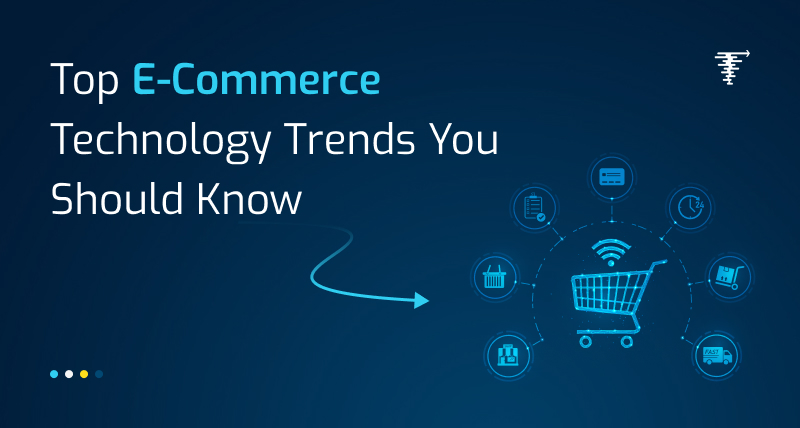

Businesses face the constant challenge of standing out from the crowd and delivering exceptional customer experiences. With rising consumer expectations and a rapidly evolving digital landscape, simply having an online store is no longer enough. Adapting and incorporating new emerging technologies in e-commerce makes all the difference.
In this post, we'll discover the top e commerce new technologies and trends poised to address online shopping challenges. They personalise the shopping journey, foster deeper customer engagement, and drive sustainable growth for your online business. So, read on to learn more.
E-commerce technology trends have paved the way for businesses to conduct themselves on digital platforms. With many businesses opting to use an e-commerce platform to enhance their business, it is only set to boom in times to come.
Undoubtedly, E-commerce has been successful for many reasons – convenience and reliability. Technology is largely in use for generating a successful e-commerce platform that is beneficial for sellers and buyers. The more enhanced and better the technology, the brighter the future of e-commerce.
Related Blog: Top Trends Defining the Future of HubSpot CRM
The unique characteristics of emerging technologies in e commerce are reliability and satisfaction, making the shopping experience better for customers.
Let's take a closer look at the 7 future technological trends of e- commerce:

AR has become a game changer for online shoppers. With the help of this technology of internet commerce, online shoppers can visualise various products (clothes and accessories). This technology has been introduced in most e-commerce platforms where people can see how they look after wearing a particular item.
This virtual trial option makes the customer's shopping experience smoother. They can try products before hitting the buy button. AR takes online shopping to a whole new level.
It's time to evolve with technology. While looking at any product on Google, you don't have to waste your time typing the name. You can use the voice search feature to get the results.
Recent decades have seen a trend in voice control systems. Adding the voice system to e-commerce is another of the best technologies for an e-commerce platform. Its convenience and effectiveness increase the number of people relying on voice search technology. Many e-commerce websites have adopted voice search technology.
Read Also: Search Everywhere Optimization
A study by Statista reveals that the global AI market will grow 826 billion U.S. dollars in 2030. According to a Study by IMB, 77% of businesses are using or exploring AI for implementing the technology in future.
AI unique features will be used on a large scale by e-commerce platforms. As customers seek more ways to enhance personalisation and services, AI will help them with product recommendations and guidance.
Today, many e-commerce retailers are investing in AI to stay tuned with the latest trend.
Masterofcode reveals that 58% of companies using B2B focused chatbot technology for maximising lead generation volumes.
Chatbot technology is already making user interaction easier with each passing day. Infact, a study by Statista states that 33% of consumers find chatbots ‘very effective’ at resolving their issues. They don't care about whether humans or machines assist them. Customers can easily interact with the salesperson.
Now, you don't need to place calls every time for communicating with customer care. Many companies have adopted this chatbot technology and provide 24*7 assistance to ensure customer satisfaction.
According to the report by PhonePe and Boston consulting group, the Indian digital payments market is expected to triple from $3 trillion to $10 trillion by 2026.
Today, almost every e-commerce platform and retailer accept digital payment like GPay, PayPal, Paytm and other digital wallets because of its convenience. However, customers should ensure privacy measures for their e-commerce site for secure payments.
Video production services are today's top e-commerce technology trend. Well-constructed product videos can effectively aid in customer experience by enabling more interactive and insightful means of representing products.
Over static pictures and text descriptions, businesses can take advantage of product videos to unlock product features, emphasise advantages, and even introduce a narrative involving a business. Studies show that customers tend to spend more on a product after viewing a video of a product.
From customer testimonials to explainer videos, none of these matters. All of these options can be found on sites such as YouTube, Vimeo, and even social networking websites. Through making a wise investment in the creation of high-quality video content, companies can help spread the word about their brand, enhance customer engagement, and make sales.

According to a study by Outerbox 2025, mobile traffic now makes up more than 60% of all website traffic, and over 70% for eCommerce traffic. This clearly shows the rising demand for mobile-first e-commerce sites for better customer experience. Now, the technological trends in e-commerce for online shopping are right in your palm or we can say just a click away from you.
According to a 2023 report by McKinsey & Company, global sales from live commerce stand to reach $350 billion by 2026. It is indeed a strong growth curve in an emerging trend in e-commerce.
E-commerce lacks the human element compared to in-store shopping, as the customer tends to feel cut off and unengaged. Live stream commerce brings the customers and the product closer together in a more engaging way. The businesses can hold live sessions showing product demos, Q&A with experts, and even customer testimonials. This way, real-time interaction helps customers develop a feeling of community with brands.
Related Blog: Latest Marketing Automation Trends
Payment options should also be limited for the sale as much as possible. The user tends to abandon carts if the favored payment option does not exist for them.
Many big brands offer multiple payment options including digital wallets, such as Apple Pay or Google Pay; credit cards; debit cards; Buy Now, Pay Later services like BNPL, and even Cash on Delivery. So that a diverse population is engaged and friction from the checkout is reduced.
In fact, cart abandonment can reach 70%, but mainly because not enough payment methods are offered to consumers (Source: Baymard Institute) Multiple options make for smoother shopping experiences but, most importantly, will expand one's market from the local environment to the worldwide environment.
Manual returns processing may consume a lot of time and resources. It may also result in prolonged processing times and frustration for customers; this could easily reflect poorly on the brand. Automating return management processes makes the entire process concerning returning and processing returned items less complicated and particularly easier to handle. Most systems include self-service portals, automated return labels, and tracking systems.
96% of customers believe easy returns are more important to a good brand experience (Source: Salesforce). However, it would be easy to reduce operational costs and increase customer loyalty through the streamlined returns process.
These emerging technologies of internet commerce are constantly evolving to meet the needs of consumers, retailers, marketers and businesses, enhancing customer experiences, increasing sales and ultimately growing their bottom line. As e-commerce trends and technology advances, businesses must stay up to date with the latest updates to remain competitive.
As we look to the future, it's clear that e-commerce new technologies will continue to shape the way we shop and interact with businesses online.
TransFunnel, #1 HubSpot Diamond Solutions partner, can help you integrate various applications within HubSpot for effective communication, smooth online shopping and much more.
Revolutionise your online store experience by partnering with us. Connect Today